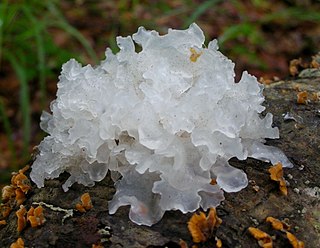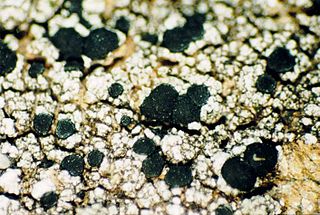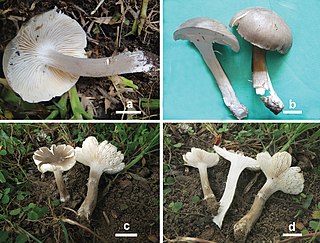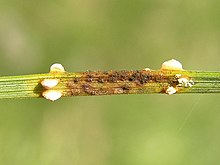
Tremella fuciformis is a species of fungus; it produces white, frond-like, gelatinous basidiocarps. It is widespread, especially in the tropics, where it can be found on the dead branches of broadleaf trees. This fungus is commercially cultivated and is one of the most popular fungi in the cuisine and medicine of China. T. fuciformis is commonly known as snow fungus, snow ear, silver ear fungus, white jelly mushroom, and white cloud ears.

The Hymenochaetales are an order of fungi in the class Agaricomycetes. The order in its current sense is based on molecular research and not on any unifying morphological characteristics. According to one 2008 estimate, the Hymenochaetales contain around 600 species worldwide, mostly corticioid fungi and poroid fungi, but also including several clavarioid fungi and agarics. Species of economic importance include wood decay fungi in the genera Phellinus and Inonotus sensu lato, some of which may cause losses in forestry. Therapeutic properties are claimed for Inonotus obliquus ("chaga") and Phellinus linteus, both of which are now commercially marketed.

Sordariomycetes is a class of fungi in the subdivision Pezizomycotina (Ascomycota). It is the second-largest class of Ascomycota, with a worldwide distribution that mostly accommodates terrestrial based taxa, although several can also be found in aquatic habitats. Some are phytopathogens that can cause leaf, stem, and root diseases in a wide variety of hosts, while other genera can cause diseases in arthropods and mammals.

Asterophora is a genus of fungi that grow as parasites on mushrooms. The genus contains four species, which have a widespread distribution, especially in temperate areas. The most recently described species, A. salvaterrensis, was found in Pinus pinaster forests in Galicia. Asterophora species are characterized by the massive production of chlamydospores in their fruit bodies and by the production of carminophilous lysosomes in their basidia. A frequently used but synonymous genus name is Nyctalis. The chlamydospores have been classified in the genus Ugola, which is an anamorphic name.

The Streblidae are a family of flies in the superfamily Hippoboscoidea, and together with their relatives the Nycteribiidae, are known as bat flies. They are winged or wingless ectoparasites of bats, and often have long legs. They appear to be host-specific, with different species of bat flies occurring only on particular species of bat hosts, sometimes with multiple species of flies sharing a host bat.

The Laboulbeniales is an order of fungi within the class Laboulbeniomycetes. They are also known by the colloquial name beetle hangers or labouls. The order includes around 2,325 species of obligate insect ectoparasites that produce cellular thalli from two-celled ascospores. Of the described Laboulbeniales, Weir and Hammond 1997 find 80% to be from Coleoptera and the next largest group to be the 10% from Diptera. Recently, the genus Herpomyces, traditionally considered a basal member of Laboulbeniales, was transferred to the order Herpomycetales based on molecular phylogenetic data. Laboulbeniales typically do not kill their hosts, although they may impair host fitness if the parasite density is high.

Xerocomus is a genus of poroid fungi related to Boletus. Many mycologists did not originally recognize the distinction between the two genera and placed Xerocomus taxa in genus Boletus. However, several molecular phylogenetic studies have demonstrated that Xerocomus is a heterogeneous genus of polyphyletic origin, which has resulted in further division of Xerocomus into Xerocomellus and Hemileccinum. The members of the genus Xerocomellus are more closely related to Boletus than true Xerocomus is, which is relatively distantly related to Boletus and more closely related to Phylloporus. Other former Xerocomus species have since been moved to Aureoboletus, Imleria, Hortiboletus and Rheubarbariboletus.
Cadophora malorum is a saprophytic plant pathogen that causes side rot in apple and pear and can also cause disease on asparagus and kiwifruit. C. malorum has been found parasitizing shrimp and other fungal species in the extreme environments of the Mid-Atlantic Ridge, and can be categorized as a halophilic psychrotrophic fungus and a marine fungus.

Phialophora is a form genus of fungus with short conidiophores, sometimes reduced to phialides; their conidia are unicellular. They may be parasites, or saprophytic.

The Lecanoraceae are a family of lichenized fungi in the order Lecanorales. Species of this family have a widespread distribution.

Tremella is a genus of fungi in the family Tremellaceae. All Tremella species are parasites of other fungi and most produce anamorphic yeast states. Basidiocarps, when produced, are gelatinous and are colloquially classed among the "jelly fungi". Over 100 species of Tremella are currently recognized worldwide. One species, Tremella fuciformis, is commercially cultivated for food.

Canoparmelia is a genus of lichen-forming fungi in the family Parmeliaceae. The widespread genus contains about 35 species. Canoparmelia, a segregate of the parmelioid lichen genus Pseudoparmelia, was circumscribed by John Elix and Mason Hale in 1986.

Collybia is a genus of mushrooms in the family Tricholomataceae. The genus has a widespread but rare distribution in northern temperate areas, and contains three species that grow on the decomposing remains of other mushrooms.

Pisolithus is a genus of fungi within the family Sclerodermataceae.

Solidago gigantea is a North American plant species in the family Asteraceae. Its common names include tall goldenrod and giant goldenrod, among others.
Myrmecridium is a genus of fungi in the class Sordariomycetes. It was circumscribed in 2007 and is distinguished from similar fungi by having entirely hyaline (translucent) vegetative hyphae and widely scattered, pimple-shaped denticles on the long hyaline rachis. The generic name derives from a combination of the Ancient Greek word "myrmekia", meaning "wart", and the suffix "-ridium" from "Chloridium".

Cantharocybe virosa is a member of the fungal family Hygrophoraceae that has been identified in India, Bangladesh and Thailand. It is an ectomycorrhizal fungus that is toxic for consumption and has no know uses in agriculture, horticulture or medicine. C. virosa is a gray to gray-brown fungus with white to yellowish-white gills that can be found in soil or on mud walls near Cocos nucifera.
Xenonectriella subimperspicua is a species of lichenicolous fungus in the family Nectriaceae. It has been recorded from South America, Europe, and New Zealand.

Coleosporium asterum is a species of rust fungus in the family Coleosporiaceae. It infects species in the Asteraceae family, such as those in genus Aster and Solidago, as well as the needle pines Pinus contorta and P. banksiana. It has been recorded on aster family species Canadanthus modestus, Eurybia conspicua, Solidago missouriensis, Symphyotrichum ciliolatum, S. laeve, and numerous others.
Tremella olens is a species of fungus in the family Tremellaceae. It produces soft, whitish, lobed to frondose, gelatinous basidiocarps and is parasitic on other fungi on dead branches of broad-leaved trees. It was originally described from Tasmania.
















